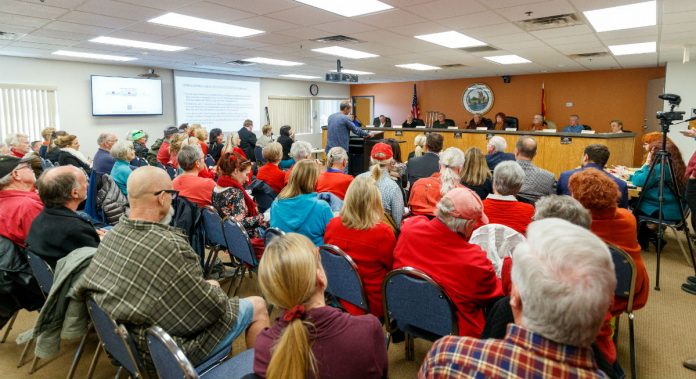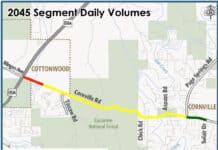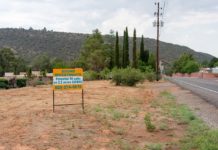
Following nearly seven hours of discussion and input, the Yavapai County Planning and Zoning Commission split their vote concerning a proposed development between Sedona and Cottonwood.
The commission’s 5-4 vote on Thursday, Dec. 19, recommended denial to the Yavapai County Board of Supervisors of a zone change to the proposed Spring Creek Ranch.
Those commissioners voting in favor of a denial were Curtis Linder, Sandra Griffis, Robert Cothern, Michael Ellegood and Bruce George.
Those in favor of the zone change were Jim Stewart, James Peterson, Dale Famas and Kevin Osterman. Mark Mumaw was absent.
More than 125 people turned out to the county complex in Cottonwood to hear the proposal being brought forward by long-time Arizona developer Eric Borowsky and his daughter, Lisa Borowsky. All but four of the dozens who spoke did so in opposition of the project. This falls in line with the number of letters and emails the county received — 245 opposed and 15 in favor.
Immediately following the meeting, Lisa Borowsky said it’s time to regroup and decide whether to request being pulled from the supervisors’ meeting agenda on Wednesday, Jan. 15.
“I’m little disappointed, as one can imagine,” she said “We would have liked the opportunity to take another swing at working with the community members. And, to have additional time to rally support, which we know is out there for us.”
As for the next step, she said, “We have options in terms of how we want to proceed from here. We re going to weigh those options and decide what’s best for our project. As to whether we postpone that [supervisors’ meeting], if we can postpone it, revise things, work with the community more and come back at a later date, I don’t know the answers to those questions at this time.”
Those commissioners who recommended denial said they saw the need for additional workforce housing but were concerned about density and the rental or purchase affordability aspect.
The Borowskys are seeking to change the zoning of their 246 acres from Residential Rural to Planned Development. Joining them in this endeavor are members of the Ryerson family, who have owned 3 acres of adjoining land since the early 1960s.
“I empathize with all the folks here today,” Osterman said. “I understand a lot of your concerns. After listening carefully I believe, without question, this applicant has planned and presented a pretty thoughtful, carefully-planned design.
“Of course, they will need to defend it with the Board of Supervisors. Is it affordable? All things considered, it may not be the most affordable by any means, but it would be for many, especially if there are two incomes in the household. One thing I have not heard from those who oppose this development is any other concrete, workable solution for workforce housing.”
Griffis saw it a bit differently.
“I get what you are trying to do, Mr. Borowsky, and I get the opposition,” she said. “We do need some sort of housing that engages that annual payroll of $35,000 like nurses, teachers and firefighters. They’re leaving because they can’t find affordable housing. But I’m extremely concerned about the density and even more concerned about the opposition. I feel there should be more community engagement to solve some of these issues. I’m a firm believer in the power of working together.”
Eric Borowsky purchased his land 15 years ago and said over those years has tried to find the right project for the area.
“Instead of building several dozen homes for millionaires, the Borowskys are here today to talk to you about a community that will house the people who live and work in the Verde Valley,” said Whitney Cunningham, the attorney for the Borowskys. “They’re also not slick, out-of-state developers.
“I think their genuineness and the amount they care for this community will come across to you. This is his [Eric Borowsky] vision. They live in the area, will have to answer to their neighbors and care about how this turns out. They want a project that helps the citizens of the Verde Valley.”
The maximum number of pads on the land they’re seeking is 1,900 manufactured home sites and 400 RV sites, down from 600. In addition, they hope to have 400 apartments — with no buildings over 30 feet high, which is the Yavapai County standard — and a 200-unit assisted living facility. Some of the manufactured homes may also be used as long-term rentals. The land is currently zoned for two-acre, residential lots.
As presented to the commission, the site would also offer a recreational facility, a general store, restaurant, park area with walking path on 60 acres of open space as well as a Verde Valley Fire District fire station and possible Yavapai County Sheriff’s Office substation.
The Borowskys said they felt a selling point is the fact there will be no age restrictions, nor will they allow any short-term vacation rentals within the community. All apartment leases will be for six months at a time. They said the family would own and manage the property, which would be developed over a minimum of six to nine years or longer depending upon demand.
Many of those opposed to the project listed a variety of reasons as to why, including density, the environmental impact, traffic, emergency access, the impact on local schools, hospitals and first responders, the affordability of the manufactured homes and apartments and the lack of a thorough site plan.
“The Cornville Community Association has met with the developers three different times,” Sam Adams said. “It’s true, they listened but that’s all they have done. No compromises were put into place. We attempted to work with them to arrive at an alternate plan and address the most objectionable aspects of this proposal like density. The developers chose not to discuss any other options put forward.”
It should be noted that this project does not call for a road to extend from the development to Cornville. Even though the project would have a Cornville zip code, Sedona and Cottonwood are closer by vehicle than is Cornville.
Bev Jackson, president of the Cornville Community Association, said she wished to summarize why the project should be rejected.
“The density of the project is wildly out of keeping with even the most populated of surrounding communities,” she said. “The development would present a clear and significant danger to Spring Creek and to the threatened and endangered species that inhabit it. The development is nearly certain to result in damage to irreplaceable Native American artifacts. And, the developer has failed to demonstrate sufficient benefit to the community that would offset the huge increase in this zoning entitlement.”





















